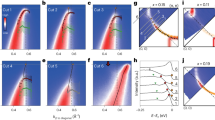Abstract
UNTIL recently, all known high- Tc superconductors involved conduction by holes; the doping of holes into the parent compound, for example by the substitution of Sr2+ or Ba2+ for La3+ in La2CuO4–y, results in a metallic state whose electronic ground state is superconducting. Recently, Tokura et al1 have discovered a series of superconducting copper oxides of general formula Ln2–xCexCuO4–y (where Ln represents Pr, Nd, Sm), with transition temperatures as high as Tc ≈ 24 K, in which the charge carriers are electrons. These compounds have the Nd2CuO4–y structure, which is similar to that of La2CuO4–y, except for a different arrangement of the oxygen atoms that results in the absence of Cu–O octahedra. Superconductivity is achieved by doping Ce4+ for Ln3+ and making the samples oxygen-deficient. Here we show, using muon spin rotation, that the parent compounds Ln2CuO4–y of these electron-superconductors exhibit static magnetic order below 300 K, which is similar to that observed in the parent compounds of hole-superconductors. In addition, fairly random static magnetic order has been observed in the non-superconducting material Nd1.90Ceo0.10CuO4–y below about 240 K, but no detectable static magnetic order was observed above 4 K in a superconducting sample Nd1.8Ce0.16CuO4–y (with a Tc of 24 K). Hence, electron doping seems not to fully destroy the magnetic order until the material becomes superconducting. The observation of static magnetic order in these new systems demonstrates that the electronic properties of these copper oxide planar systems are at least partially symmetric with respect to electron and hole doping.
This is a preview of subscription content, access via your institution
Access options
Subscribe to this journal
Receive 51 print issues and online access
$199.00 per year
only $3.90 per issue
Buy this article
- Purchase on Springer Link
- Instant access to full article PDF
Prices may be subject to local taxes which are calculated during checkout
Similar content being viewed by others
References
Tokura, Y., Takagi, H. & Uchida, S. Nature 337, 345–347 (1989).
Schenck, A. Muon Spin Rotation Spectroscopy: Principles and Applications in Solid State Physics (Hilger, Bristol and Boston, 1985).
Uemura, Y. J. et al. J. de Physique (Paris) Coll. (in the press).
Uemura, Y. J. J. appl. Phys. 64, 6078–6091 (1988).
Nishanda, N. et al. Jap. J. appl. Phys. 26, L1856–L1858 (1987).
Aeppli, G. et al. Phys. Rev. B35, 7129–7131 (1987).
Gygax, F. N. et al. Europhys. Lett. 4, 473–479 (1987).
Uemura, Y. J. et al. Nature 335, 151–152 (1988).
Uemura, Y. J. et al. Phys. Rev. Lett. 59, 1045–1048 (1987).
Uemura, Y. J. et al. Physica C 153–155, 769–770 (1988).
Brewer, J. H. et al. Phys. Rev. Lett. 60, 1073–1075 (1988).
Uemura, Y. J., Yamazaki, T., Harshman, D. R., Senba, M. & Ansaldo, E. J. Phys. Rev. B31, 546–563 (1985).
Saez Puche, R., Norton, M., White, T. R. & Glaunsinger, W. S. J. Solid State Chem. 50, 281–293 (1983).
Weidinger, A. et al. Phys. Rev. Lett. 62, 102–105 (1989).
Author information
Authors and Affiliations
Rights and permissions
About this article
Cite this article
Luke, G., Sternlieb, B., Uemura, Y. et al. Studies of static magnetic order in electron-superconductors and their parent compounds. Nature 338, 49–51 (1989). https://doi.org/10.1038/338049a0
Issue Date:
DOI: https://doi.org/10.1038/338049a0
Comments
By submitting a comment you agree to abide by our Terms and Community Guidelines. If you find something abusive or that does not comply with our terms or guidelines please flag it as inappropriate.



